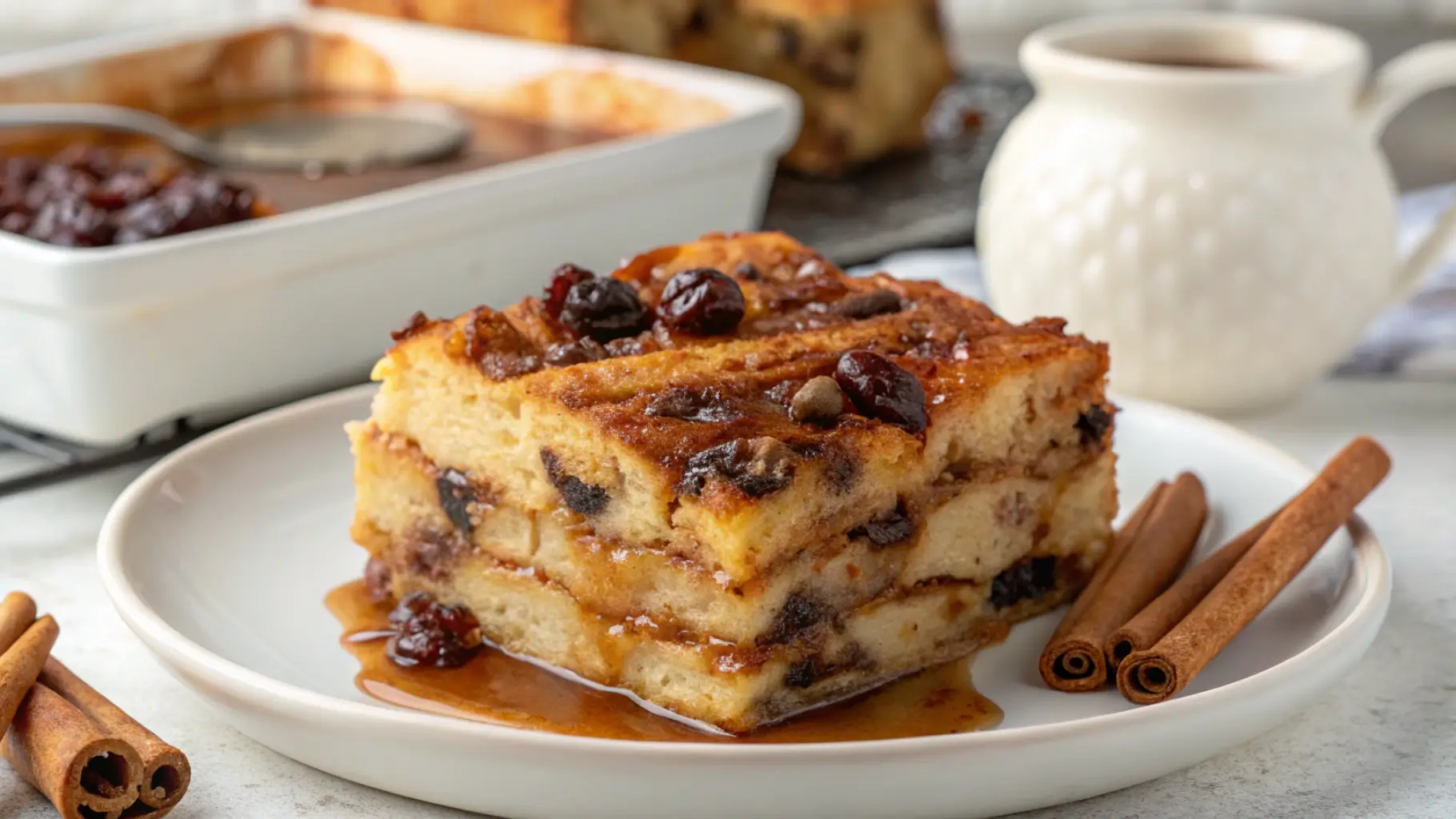The thing about Capirotada is it doesn’t really make sense. Not at first. Cheese in a sweet dish? Layers of dried bread soaked in piloncillo syrup? If you didn’t grow up with it, you’d probably hesitate.
But if you did… you already know. The scent alone cinnamon, cloves, that deep caramel of melted piloncillo pulls you back. To Lent. To family kitchens. To stories told while waiting for it to bake.
And maybe that’s what makes this Mexican bread pudding special. It’s not just food. It’s memory you can taste.
Table of Contents
What Is Capirotada?
Honestly, Capirotada is hard to explain if you haven’t tasted it. You say it’s a sweet, cheesy bread casserole and people tilt their heads. But in many Mexican homes, especially around Lent, it’s just… expected. Like tamales in December or pan dulce with your coffee.
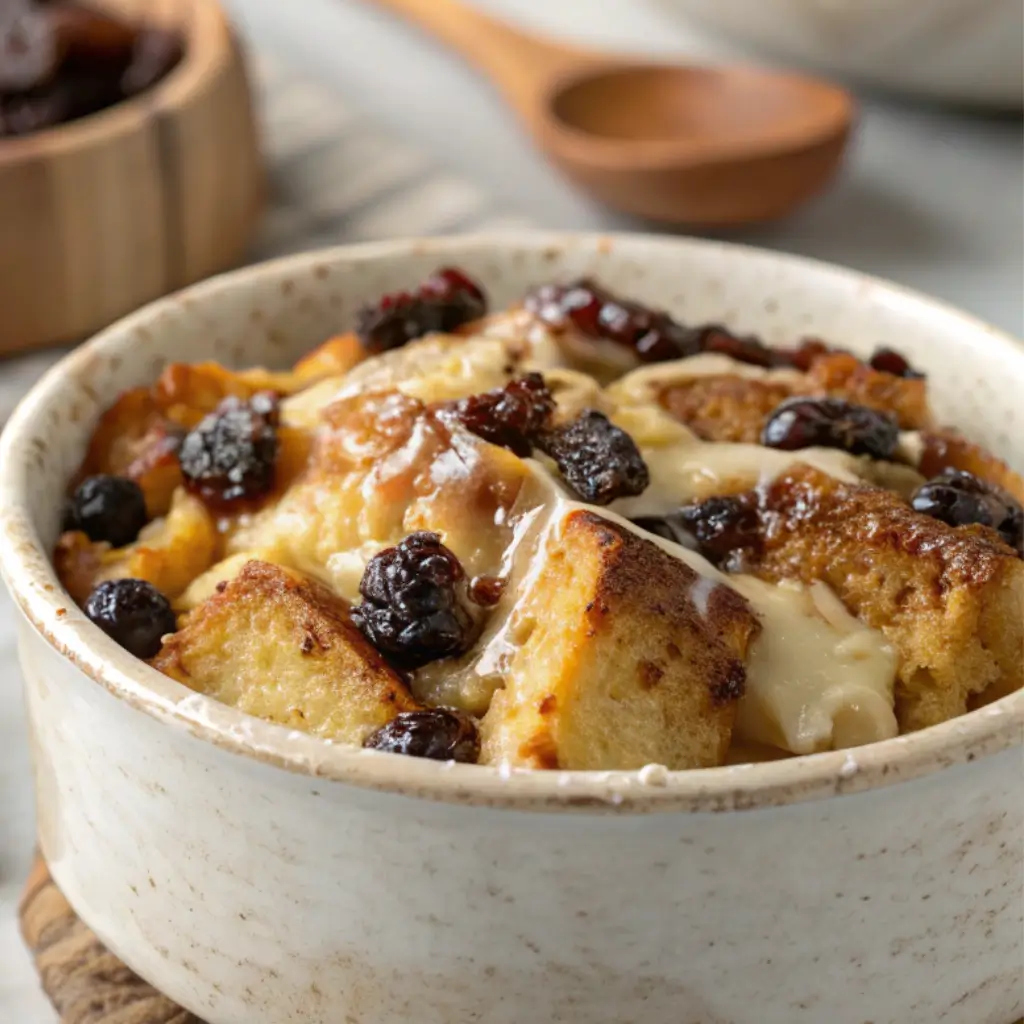
Technically, it’s a type of Mexican bread pudding but not like the creamy, custardy kind some folks might picture. This one’s layered. Toasted bread. Sticky piloncillo syrup steeped with cinnamon and cloves. A sprinkle of raisins. And yes, cheese. Not as an afterthought, but baked right in.
The Strange Logic of Tradition
What’s wild is how it works. That salty cheese against all the sweetness? You’d think it clashes. It doesn’t. It rounds everything out, somehow. Like how old family stories feel better when told out loud, even if they don’t quite make sense.
And maybe that’s part of why this dish has lasted. Capirotada has roots going back hundreds of years Spanish monks, indigenous adaptations, Lenten fasts. Somewhere along the line, it became more than just food. It became a ritual.
Why No Two Batches Are Alike
Every family has their own take. Some swear by cheddar, others use queso fresco. Some mix in nuts, bananas, even sprinkles. Others keep it plain—just syrup, bread, and memory. And you know what? They’re all “right.” Because what you grow up with becomes the standard, even if it’s wildly different from what’s “authentic.” To learn how this dish bridges food and faith, KCRW explores capirotada’s Lenten symbolism and why it’s such a powerful cultural tradition.
FAQ – What does Capirotada mean?
Where does the name Capirotada come from?
It traces back to the Spanish word capirote, a religious hood worn during Holy Week. The dish, layered and humble, carries that same spiritual weight just on a plate.
Ingredients & Their Symbolism in Capirotada
You ever look at a dish and think wait, that’s it? Just bread, a bit of piloncillo, maybe some cheese, a few spices… and yet, somehow it hits you harder than expected. That’s Capirotada. Nothing fancy. Just… familiar things that somehow carry more weight than they should.
But each one… means something. Or at least, it used to.
A Quiet Kind of Symbolism
- The bread? That’s said to represent the body of Christ.
- The sticky piloncillo syrup—his blood.
- Cloves, cinnamon—some say they’re like the nails and the wooden cross.
- The melted cheese? A little strange, but it’s supposed to be the burial shroud.
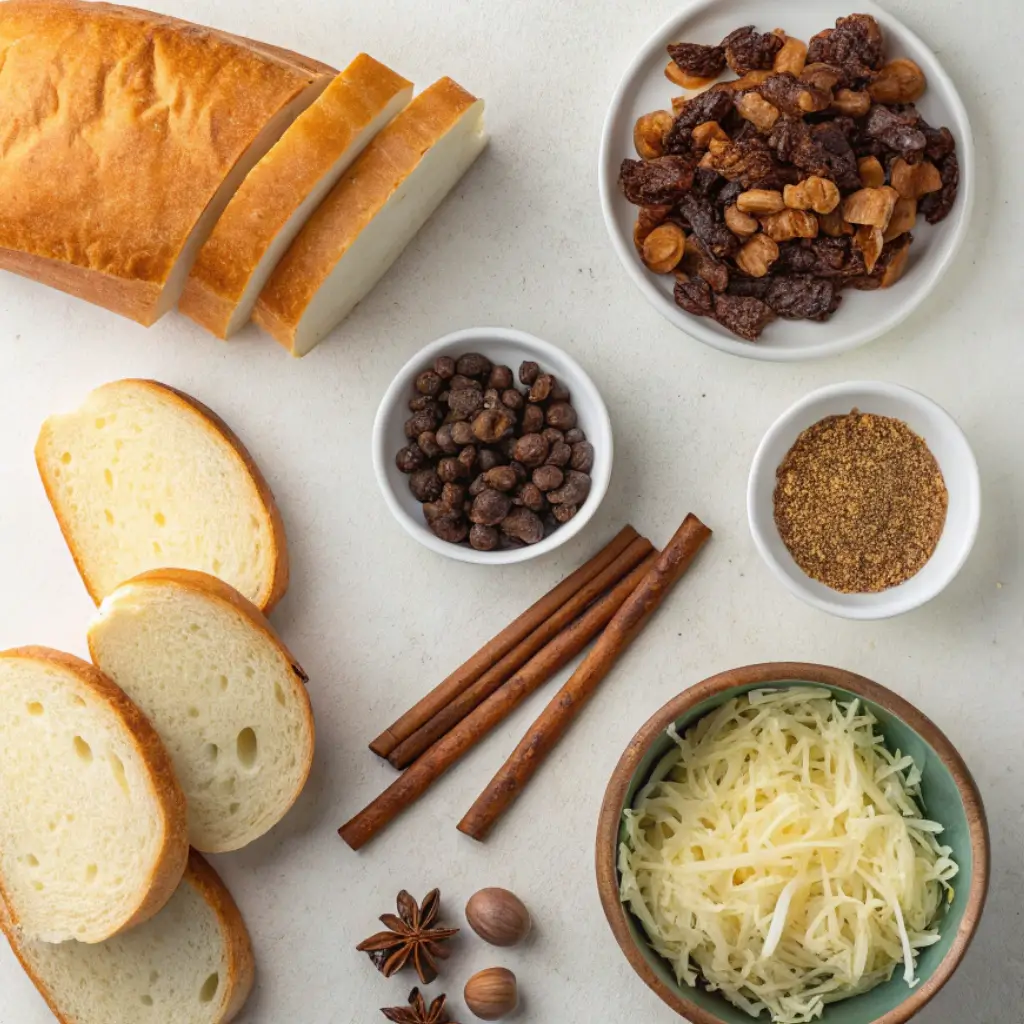
It’s a lot, right? And yet, if you grew up with it, this all kind of settles in the background. You’re not thinking theology as you layer the ingredients. You’re just… making Capirotada.
Everyday Food, Sacred Meaning
Here’s what’s real: this dish didn’t come from luxury. It was born from what people had stale bread, pantry spices, maybe a wedge of cheese. It was practical. And over time, it became more than that.
Not every family leans into the religious part. Some don’t even know the symbolism exists. They just know Capirotada means Lent, and Lent means family. Or quiet. Or memories.
That’s enough.
FAQ – Does Capirotada always have religious meaning?
Is the symbolism part important to every version?
Honestly? No. Some families pass it down like any recipe—no backstory. But for others, especially during Lent, those layers carry more than flavor.
Step-by-Step: How to Make Capirotada
Making Capirotada? It’s not hard, not really but it’s not the kind of thing you just throw together either. You dry the bread (not too much, but enough), you get the syrup going… and somewhere along the way, you realize you’ve been standing there for five minutes just smelling it. That mix of piloncillo and cinnamon kind of pulls you in before you even notice.
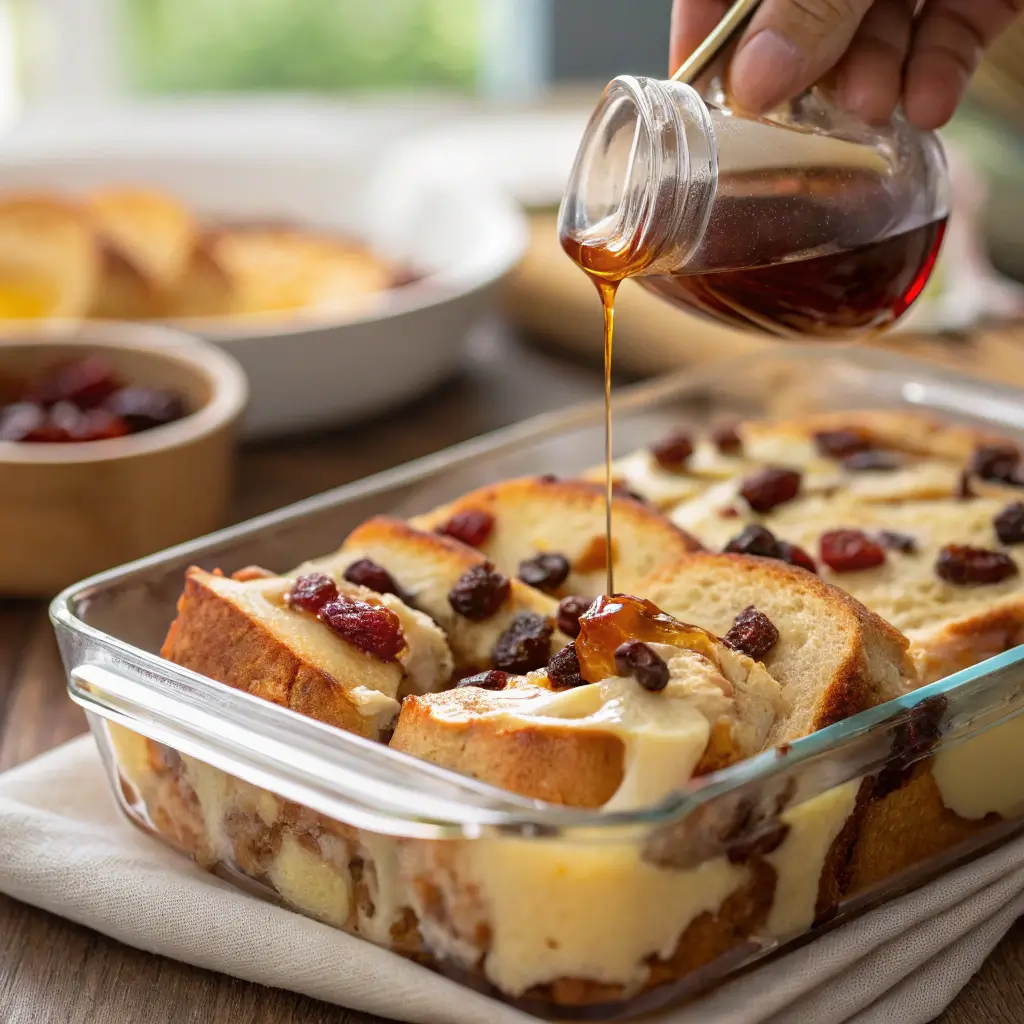
This isn’t quick-bake cookie energy. It’s slow. Layered. Almost meditative.
Step 1 – Toast the Bread
Grab your bolillo rolls and slice them into thick, half-inch rounds. Butter both sides—yes, both and lay them out on a sheet pan. Into the oven at 350°F. Just a few minutes per side. You’re not going for crisp, just… dry. Like they’ve been sitting out a little too long, in the best way.
Step 2 – Make the Syrup
Toss the piloncillo, cinnamon, cloves, and water into a pot—doesn’t need to be fancy. Crank the heat until it boils, then drop it down and let it bubble gently. After 15, maybe 20 minutes, the smell kind of creeps into everything—your hair, your clothes, that corner of the house you forgot was there. If you love syrupy, old-school desserts, you might also enjoy our Chocolate Gravy Recipe — another Southern classic with deep roots and sweet comfort.
Then strain out the spices. Syrup’s ready.
Step 3 – Build the Layers
Spray a baking dish. Start layering: some bread, a handful of raisins, a fistful of cheese, then pour warm syrup over the top—just enough to make things glisten. Let it sit. Ten, fifteen minutes. Then do it again. Bread. Raisins. Cheese. Syrup. It’s kind of like building a memory one scoop at a time.
Do three full layers, resting between each. The last one’s your top hat—make it count.
Step 4 – Bake
Cover it in foil (spray the foil, or you’ll regret it) and slide it into the oven for 40 minutes. Then pull off the foil and let it go uncovered another 10 or so—until the top gets a little color and the cheese is all kinds of molten.
It’s going to smell amazing. Resist. Give it 10 minutes to cool down, or you’ll nuke your tongue.
FAQ – Can I prep Capirotada ahead of time?
Can I build the whole dish and bake it later?
Absolutely. Assemble it, cover it tight, and chill it in the fridge overnight. Bake fresh the next day. It actually soaks up more flavor that way.
Regional Variations & Modern Twists on Capirotada
Ask five Mexican households how they make Capirotada, and you’ll get five answers and probably five slightly offended reactions when you suggest any one of them is “the right way.”

That’s the thing: this dish is personal. What feels like a sacred flavor combo in one kitchen might seem totally bizarre in another. And that’s okay. It’s exactly how food traditions survive by shifting slightly with every hand that makes them.
Region to Region, Pan to Pan
- In parts of Michoacán, the version is bare-bones no coconut, no milk, no fuss. Just the basics: bread, piloncillo, cheese, raisins, maybe a few cloves.
- Over in Jalisco, you might find coconut, banana slices, even peanuts tucked into the layers.
- Some northern families swear by using queso fresco instead of cheddar milder, softer, less salty. Others go completely off-script, embracing unexpected flavors, like in this Pistachio Cream Dessert, where texture and heritage take a creative turn.
- Others splash in sweetened condensed milk or even make a version with tres leches-style soaking.
There’s even a sprinkle crowd. Literal rainbow sprinkles. Don’t knock it till you’ve seen it glisten under warm syrup.
And if you love soaked desserts with history, check out our upcoming recipe for Tres Leches Cake, another Latin American icon built on humble ingredients and nostalgia
Build Your Own Tradition
If you’re new to Capirotada, don’t stress the “rules.” Start with the core bread, piloncillo syrup, cheese, raisins then tweak.
Try:
- Adding pecans, almonds, or pepitas for crunch.
- Swapping in dried cranberries, apricots, or dates if you’re not a raisin fan.
- Using Monterey Jack, queso Oaxaca, or even cream cheese crumbles if cheddar’s too sharp.
Let your taste memory guide you or just your taste.
FAQ – Is it still Capirotada if I tweak it?
If I change a bunch of ingredients, is it still “authentic”?
Who’s to say? Authenticity isn’t one fixed flavor. If your version carries a story or if it creates a new one, it counts. Make it yours.
Storage, Serving & Reheating Tips for Capirotada
One thing about Capirotada you usually have leftovers. And honestly? That’s not a bad thing.
This dish changes a little after a day. The sweetness deepens, the cheese settles into the bread, and everything softens. Some folks even swear it’s better the next morning with coffee. No shame in that.
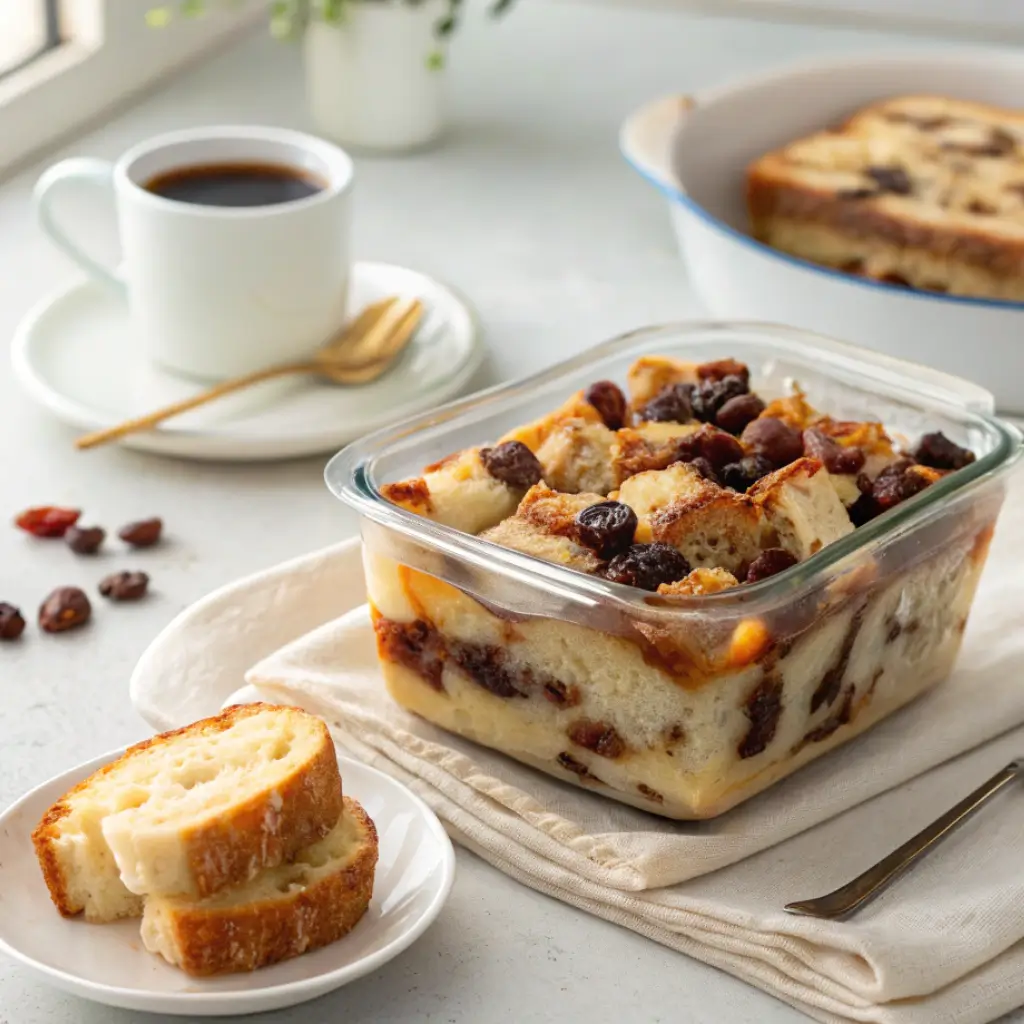
Storing It (Without Turning It to Mush)
Let it cool all the way, seriously, all the way before you cover it. According to USDA food safety guidelines, this helps prevent condensation and spoilage. Steam wrecks texture.
- Fridge? Yup. Just wrap it tight or use a sealed container. It’ll last around 4 days, easy.
- Freezer? If you must. Wrap it snug and it’ll hang in there for a couple months. Just thaw slowly fridge overnight works best.
Warming It Up Again (or Not)
- If you’re going oven-style: cover with foil and reheat at 350°F. Give it 10–15 minutes.
- For microwave folks: small portions, short bursts. Like, 30 seconds max. You want it warm not rubbery.
Want to freshen it? A splash of cream or leftover piloncillo syrup before reheating can work wonders.
That said… you don’t have to reheat it. Cold Capirotada? Not illegal. Not even weird.
FAQ – Is cold Capirotada a thing?
Can you eat it straight from the fridge?
Yeah, totally. Some people prefer it chilled. Others say it’s not Capirotada unless it’s warm. There’s no rulebook here do what feels right.
Frequently Asked Questions About Capirotada
People have strong opinions about Capirotada. But even if you didn’t grow up with it, the curiosity hits fast: What’s in it? Why the cheese? Is it always sweet? Let’s clear a few things up.
Is Capirotada always sweet?
Most versions are, yeah but there are older recipes that leaned savory. Over time, the piloncillo syrup took center stage. If yours isn’t sweet, or has less syrup, that might just be your family’s take.
Why is there cheese in it?
Sounds weird until you try it. The cheese gives it a salty edge that balances out the syrup. Think of it like eating apples with cheddar sweet meets savory. Strange combo, perfect bite.
Do I have to use piloncillo?
Ideally, yes. It has a rich, almost smoky depth that plain sugar just can’t touch. But if you’re stuck, dark brown sugar gets you close. Add a splash of molasses if you want to fake it a bit more.
Is this dish always made for Lent?
That’s the tradition, but lots of folks make it year-round. It’s associated with Lent because of the religious symbolism but nowadays? Some people just crave it, symbolism or not.
What does “Capirotada” even mean?
It comes from capirote—a religious hood worn during Holy Week. The name stuck, probably because the dish is layered like fabric and tied to that season.
Final Thoughts on Capirotada
Some dishes just… stay with you. Not because they’re fancy. Not even because they’re your favorite. Capirotada is one of those. It’s simple, yes but it lingers.
Sometimes it’s about Lent. Sometimes it’s not. It might’ve been your mom’s thing. Or your neighbor’s. Or maybe it’s brand new to you, and still, weirdly, it feels like something you should’ve known sooner.
And really, that’s kind of the point.
You don’t need to get it “right.” You don’t need to explain why cheese and syrup and bread work together. Sometimes comfort food just works like our Spicy Fried Rice, bold and satisfying in its own unique way.
That’s enough.

